Miami City Ballet / New York City Center / January 21-25, 2009
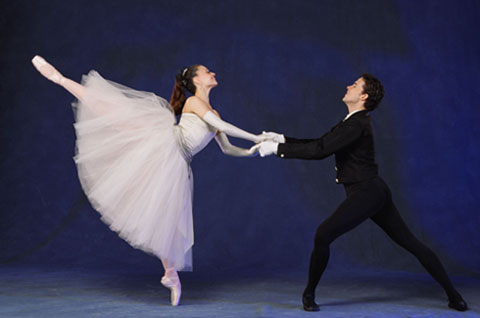
Jennifer Kronenberg and Carlos Guerra of Miami City Ballet in Balanchine’s La Valse. Photo by Joe Gato.
At Miami City Ballet’s opening night at New York City Center–the company’s long-awaited Manhattan debut–the curtain rose on a bevy of gorgeous, long-limbed young women in rakish pony tails and plain white leotards, reaching into space in a diagonal line that stretched cross-stage. The line then undulated, wave-like, in perfect formation, as if an electric impulse were coursing through it. This striking image, from Balanchine’s Symphony in Three Movements made the choreography look born again.
The full article appeared in Voice of Dance (http://www.voiceofdance.org) on January 30, 2009. To read it, click here.
Archives for January 2009
School of American Ballet Celebrates 75th Anniversary
New York City Ballet: School of American Ballet 75th Anniversary Tribute / David H. Koch Theater / Lincoln Center, New York City / January 14, 2009
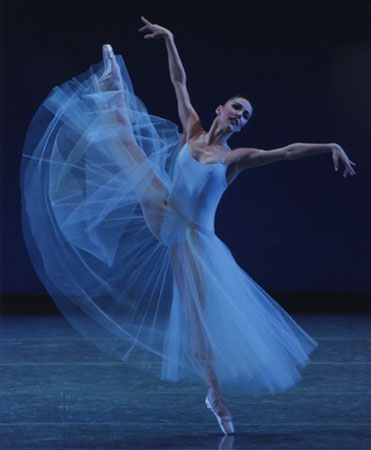
Patricia Delgado in Balanchine’s Serenade. Photo by Paul Kolnik.
I remember a time when it was informally called “The School,” as if the School of American Ballet, founded by George Balanchine and Lincoln Kirstein as the breeding ground for what would become the New York City Ballet, were the only teaching institution in America guaranteed to produce top-notch classical dancers. This was not the case even back then and it is certainly not the case now, but SAB is still the only American academy ranked with the schools of St. Petersburg’s Kirov Ballet (Balanchine’s alma mater), Moscow’s Bolshoi Ballet, and the Paris Opera Ballet.
The full article appeared in Voice of Dance (http://www.voiceofdance.org) on January 22, 2009. To read it, click here.
‘New Combinations’ Takes City Ballet to ‘Life’ Class
This article originally appeared in the Culture section of Bloomberg News on January 26, 2009.
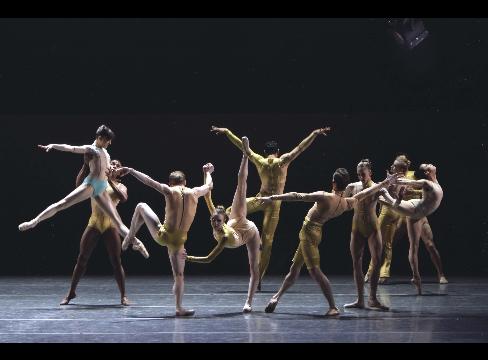
New York City Ballet dancers take part in a performance of “Lifecasting” in New York in this undated handout photo. Performances continue through March 1 at Lincoln Center’s David H. Koch Theater. Photographer: Paul Kolnik/NYCB via Bloomberg News
Jan. 26 (Bloomberg) — For George Balanchine’s birthday last Thursday at Lincoln Center’s David H. Koch Theater, the New York City Ballet premiered Douglas Lee’s “Lifecasting,” a dark yet strangely emotionless fantasy.
It was part of the company’s annual New Combinations evening, intended as a tribute to the master, who died in 1983. The tone of the piece is grave; the choreography, weightily somber. Yet it made me think, irreverently, of a child’s dream about classical statues in a museum coming to life when no one’s looking.
“There are no new steps, only new combinations,” Balanchine once declared. Peter Martins borrowed from this when he initiated the project, which has turned out to be a mixed blessing as gifts go. Usually it results in ballets less than wonderful, by choreographers trying too hard to look like the latest on the cutting edge.
One expects more persuasive results from Lee. Born in England, he trained at the Royal Ballet School, is now a principal dancer with the Stuttgart Ballet, and has participated in City Ballet’s New York Choreographic Institute. Yet, as we see time and again, pedigree alone doesn’t do the trick.
Set to music by Ryoji Ikeda and Steve Reich (not so odd a couple as you might think), “Life Casting” takes its title from the sculptor’s process of making casts directly from the human body. We see a bevy of dancers in a generically stark, handsome set, clad by Ines Alda in pale leotards suggesting plaster. Dancers are routinely considered a life force, but these are often eerily still or at least rooted to one spot, one of them always lying supine, as if laid out in death.
No Human Emotion
Matters eventually get somewhat livelier — bodies group themselves variously, small ones form to manipulate a single pliant figure — yet obdurately refuse to project any human feeling or purpose.
I enjoyed the movement Lee contrived, encompassing both the sinuous and the angular, but I remain baffled by what the choreographer expected his audience to make of it. The standouts in the cast were Robert Fairchild, Kaitlyn Gilliland and
Maria Kowroski.
This year’s New Combinations is subtitled “A Tribute to Nureyev,” in recognition of the Rudolf Nureyev Dance Foundation, which initiated a program of ongoing support for so-called emerging choreographers to work with the company. Unfortunately one of this year’s planned new works, by the Russian Alexey Miroshnichenko, had to be postponed until 2010.
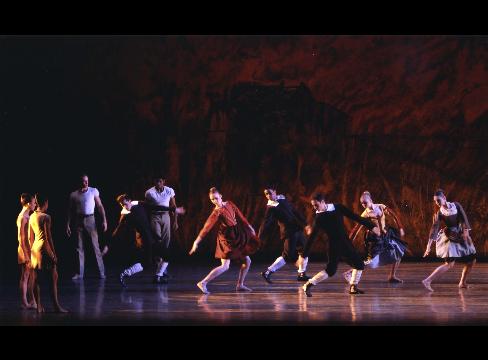
New York City Ballet dancers take part in a performance of “La Stravaganza” in New York in this undated handout photo. Performances continue through March 1 at Lincoln Center’s David H. Koch Theater. Photographer: Paul Kolnik/NYCB via Bloomberg News
The program was fleshed out with the pas de deux from August Bournonville’s charmingly flirtatious “The Flower Festival at Genzano,” Angelin Preljocaj’s incomprehensible “La Stravaganza,” the poignant pas de deux from Christopher Wheeldon’s “After the Rain,” and Balanchine’s “Theme and Variations,” evoking the brilliant grandeur of the Maryinsky tradition in its heyday.
Wouldn’t you know that, of these, the oldest, “Flower Festival” (1858) and “Theme” (1947), boasted the best choreography. You can usually, though not always, trust generations of viewers to know what’s worthy of an ongoing life.
The balletomanes in the audience succumb to Bournonville’s intricate steps; the rest of the crowd, to the charm the piece exudes. And surely everyone watching “Theme” these days can use a dose of palatial elegance.
Through March 1 at Lincoln Center, Broadway at 65th St. Information: +1-212-721-6500; http://www.nycballet.org.
© 2009 Bloomberg L.P. All rights reserved. Reprinted with permission.
Pink: Personal Indulgences No. 12
A young girl of my intimate acquaintance, let’s call her Eve, decided at the age of three or so that, when she grew up, she was going to be a boy.
She liked to play pretend games. You may remember them from your own childhood–those acted-out narratives, full of exciting incident, that have an endless life, with plots and characters repeating variations on a few themes presumably of deep significance to the players. In her “pertends,” as Eve called them, she invariably assigned herself the role of a man or boy. She was Joe. She was Nick. She was Doug. When I was her abettor–being a great fantasist myself, how could I not indulge her excursions to imagined worlds?–it took me a while to convince her that I like being a girl and so sometimes wanted to play a girl role. But Eve is a generous, tolerant soul and eventually let me be Helen or Jane.
Her kindergarten friends were nearly all boys. On her long, swift Atalanta legs, she ran around the playground with “the guys” in wild games of tag. With her pale coloring, slender build, and unconscious grace, she resembled a Victorian illustrator’s idea of a fairy. She concealed her rippling cornsilk hair firmly under a baseball cap until she persuaded her parents to let her cut it short, then shorter. In truth, she still didn’t look like a boy. She looked like Peter Pan.
But I believed in Eve’s earnestness in becoming a boy. I was convinced by an outing with her and her elder sister to a Chinatown emporium that sells thousands of things you didn’t know you needed. There we discovered a cache of tiny old-fashioned advertising cards. Flimsy bits of paper smaller than a Metro card, most of them pictured sentimentally lovely Asian women of the 1920s or 30s. A few, instead, showed exotically uniformed warriors of yore poised for battle. About 300 cards lay in a small wicker basket. Ten for a dollar. I told the girls they could each choose ten. Methodically, they examined each and every card. Eve’s sister found them irresistible and had trouble limiting her choices to ten. Eve found only two she wanted. The guys with the spears, of course.
Oddly enough, Eve’s passion to be a member of the opposite sex peaked with a seemingly trifling symptom: a hatred of pink. The color was anathema to her. She noticed it constantly–on people, in shop displays–greeting it with noises of disgust. Her sister would join in with relish, pointing out a gossamer blush-tinted bridesmaid’s gown displayed in the window of a tailor’s shop, and declare, “Now there’s something for you, Eve,” and the two would produce a racket of “Euew! Gross!” between attention-getting giggles.
After a while, however, Eve, gifted for art as well as baseball, found that she had no objection to using pink in her paintings. It was now offensive only in clothing. Since she bought all her clothes in the boys’ department, she was not often threatened by rosy hues. I did enjoy pointing out to her one day a twenty-something person of the male persuasion sporting a t-shirt that declared, full-frontally, “REAL MEN WEAR PINK.”
These days, now approaching the end of first grade and her second season as a Little Leaguer, Eve is softening on many fronts. She’s thought it through carefully, it would seem, and decided she is a girl and that that condition is fairly permanent–a given, really. Lately she’s even been planning names for her children. The roster of offspring, apparently, will include representatives of both genders. So Joe and Jane have a chance of being born into real life, as Eve scrupulously defines the opposite of her “pertends.” Still, the prospect of becoming a mother takes second place in her imagination to another deeply felt plan for her future. She intends to be a writer. I haven’t the heart to dissuade her. Yet.
© 2009 Tobi Tobias
Gloomy Cedar Lakers Leap Into Silly Stratosphere
This article originally appeared in the Culture section of Bloomberg News on January 9, 2009.
Jan. 9 (Bloomberg) — What can money buy? Cedar Lake Contemporary Ballet offers its 15 dancers most poverty-stricken artists’ dream: steady employment and health insurance, a rare luxury for American artists.
The trendy young company is performing through Jan. 18 at its own theater in Manhattan’s Chelsea district. Wal-Mart heiress Nancy Laurie, whose wealth makes the group possible, and Benoit- Swan Pouffer, its artistic director, are building a repertory dominated by foreign choreographers that lends the company an avant-garde air. In truth, Western concert dance has gone global, but audiences still enjoy the myth of exotica.
The dancers, who range from good to very good, are set in motion more in the vein of postmodern dance than classical ballet, though ballet training contributes to their virtuosity. The choreography is mainly dreadful — pretentious and often unfathomable. Typically, it bombards the stage with ferocious non-stop action, athletically and sometimes erotically charged, unrelieved by contrasting repose other than a glum catatonia. What ever happened to delight?
‘memory/measure’
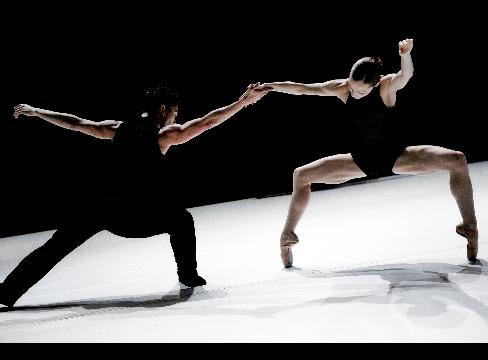
Dancers Jon Bond, left, and Acacia Schachte take part in the Cedar Lake Contemporary Ballet performance “memory/measure” by Luca Veggetti in New York on Dec. 13, 2008. The company is performing through Jan. 18, 2009 at its own theater in Manhattan’s Chelsea district. Photographer: Julieta Cervantes/Cedar Lake Contemporary Ballet via Bloomberg News
One of the two world premieres on the program fulfills this description perfectly. The Italian Luca Veggetti’s “memory/measure,” scored for voice and electronic cacophony by Paolo Aralla, places two couples in funereal black practice clothes on a chalk-white floor cloth and has them illustrate alienation. Their isolation, despite moments of physical contact, neither holds nor projects emotion. They accept their doom without comment, like citizens of a country subject to perennially gray weather. The action of the piece goes nowhere, as if feeling, or even the passage of time, didn’t exist.
Maybe someone whispered in Nancy’s or Benoit-Swan’s ear, “Lighten up.” The second world premiere on this season’s program, Didy Veldman’s “frame of view,” moves from the usual grim postmodern news Cedar Lake delivers to tame attempts at silliness. The juxtaposition is confusing and becomes increasingly so as the piece goes on and on and on.
It has a terrific set, by Miriam Buether, that uses frames to create the illusion of translucent black walls punctuated by three solid doors that suggest French bedroom farce. But no such luck: A couple making out on opposite sides of a stretch panel in one of the doors is less amusing than faux-surreal.
The denizens of Cedar Lake are not destined for frivolous gaiety. A fellow hides behind a door, presumably to his home, besieged by a bunch of light-hearted confetti-tossing celebrants, refusing to admit them to a party to which he’s presumably invited them. A moment later, still in his living room, he’s sprinkling his own tiny showers of confetti at a gargoylish man who’s captured a terrified maiden.
This piece doesn’t know its own mind and is far too long. The finale is the last straw. The dancers parade around the perimeters of the set as a litany of their fears is heard on tape.
My favorite: “I’m afraid of dancing.”
Through Jan. 18 at the Cedar Lake Theater, 547 W. 26th St. Information: +1-212-868-4444; http://www.cedarlakedance.com.
© 2009 Bloomberg L.P. All rights reserved. Reprinted with permission.



